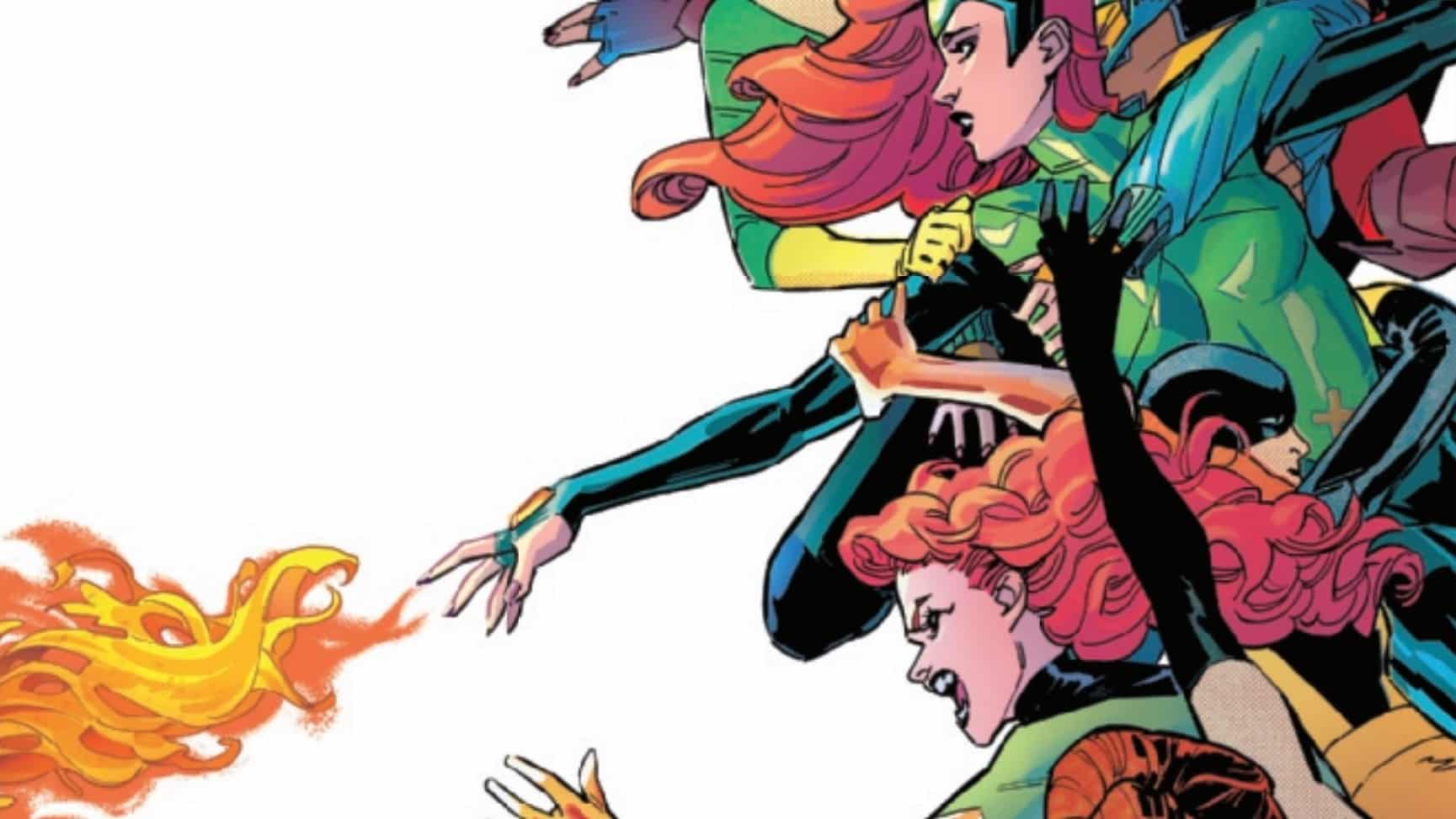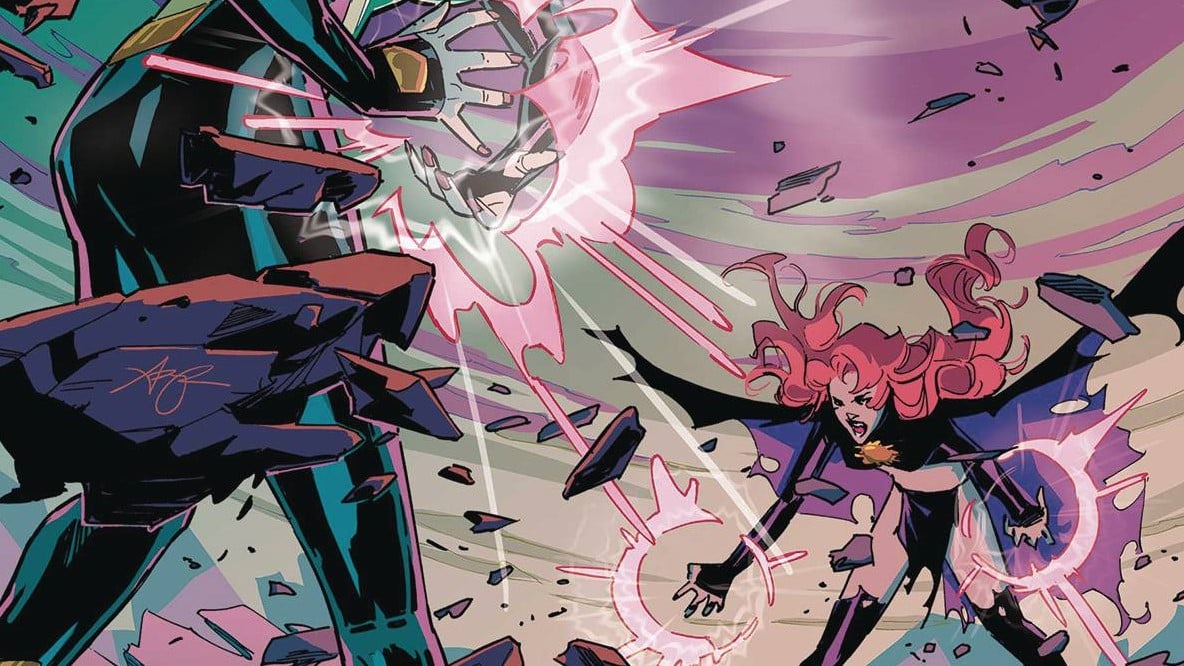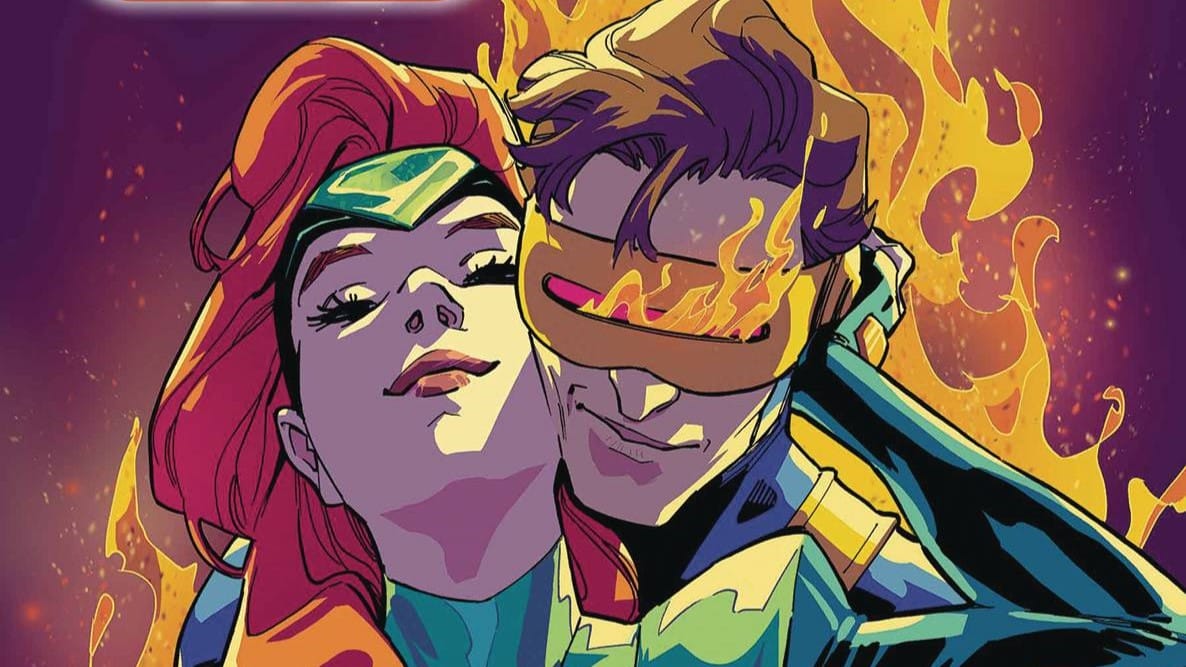It’s a white hot cavalcade of Jeans Grey in the fiery final issue of our title character’s time-spanning reckoning with her tumultuous past(s). With the future of mutantkind on the line, will Jean douse the flames, or fan them? Jean Grey #4 is written by Louise Simonson, drawn by Bernard Chang, colored by Marcelo Maiolo and lettered by Ariana Maher.
Anna Peppard: Well, here we are at the end of Jean’s journey through (some of) her most iconic deaths and resurrections and a bunch of new ones to boot — or is it just the beginning? Endings and beginnings don’t mean much for serialized superhero stories, and even less for superheroines with an on-again, off-again relationship with cosmic firebirds that like to spout riddles about the sensual tryst of death and rebirth.
This comic, like others in this series, embraces this multitudinous continuity to paint an affecting portrait of one of the X-Men’s most complex — and important — characters. It also falls victim to the limits of shared-universe serialization, shunting crucial elements of its climax into another comic with a different writer that hasn’t come out yet.
But the vibes are on-point, so I’m gonna lead with feelings. Setting aside structural issues we’ll discuss in due course, how are you feeling about this issue, Adam?
Adam Reck: Upon first read, I had equal amounts of feeling bowled over by Louise Simonson’s abilities, but also feeling the confines of what this series was being allowed to do. I was impressed by, as you noted, the comprehensive understanding of what made Jean Jean, but disappointed that it didn’t add up to something bigger … yet. This is also the first issue without a real “What If?” scenario at its core, so it seemed out of keeping with the others and more like the final paragraph in a persuasive essay.
Anna: And speaking as someone who grades a lot of essays, it is very persuasive! Weezie does a fine job arguing that whatever flaws and limits this series might have had are actually strengths, if you think about it from another angle (or three or four).
Adam: I’m very excited to dig into what Weezie and Chang are trying to do here. Or maybe measure the angles?
Anna: I always ensure my writer’s toolbox is equipped with a compass and protractor.
Adam: Oooh, pointy!
What If Jean replayed her What Ifs?

Anna: The basic format of this issue is a recap and reflection on the previous three issues, with Jean confronting (or, more appropriately, being confronted by) the versions of herself whose pasts and futures she tried to rewrite, with disastrous results in every case. We start with a confrontation with Teen Jean before moving on to the Jean who first bonded with the Phoenix in the shuttle accident (I’m dubbing her Shuttle Jean) before moving on to Madelyne Pryor. Other Jeans take a line here and there, but these are our three anchor points.
Adam: This structure was a surprise for me. I was not expecting the first three issues to come back to take our central Jean to task for her “What If?” choices. But it does make sense because this is how our minds work. We imagine what could have been and then berate ourselves for why even our mental fantasy revisions are terrible ideas. I do think Chang’s artwork feels more rushed in this issue, and it contributes to some visual confusion in certain panels about which Jean is which and who exactly is addressing whom. This couldn’t be an easy issue to draw given all of Jean’s permutations.
Anna: I noticed right away that the backgrounds were sparser, which fits the setting of the White Hot Room but wasn’t as visually dynamic as it could have been. And since learning (through your Battle of the Atom NYCC special!) that Chang and Simonson have been creating this series using the so-called “Marvel Method,” i.e., with Simonson scripting over visuals Chang creates from a general plot, I’ve been thinking more deeply in general about the visual storytelling of this series, and how much certain emotional beats depend on Chang’s skills and choices. There’s a whole lot of important visual storytelling in this particular issue, and while some moments work better than others, when it lands, it lands.
Take the first confrontation with Teen Jean, who moves and changes, over the course of the exchange, from her familiar bob-haired version through at least three other incarnations created by Simonson and Chang for the alternate past/future we were given in Jean Grey #1. The tone and content of Teen Jean’s dialogue changes as she does, from a teenager into a woman into a particularly vengeful version of the Phoenix. We also need to keep in mind that this is Jean Prime creating these visions, this dialogue. Every conversation she’s having here (perhaps including later conversations with the Phoenix itself) is actually a conversation with herself. Chang needs to illustrate this high-concept headyness while maintaining clarity and grounded emotional beats. This is an issue you can get lost in if you want to, but for the most part, I mean that as a compliment, not a criticism.
Adam: This shifting is done quite subtly through costume and hair changes, but the art doesn’t feel as dynamic here as it has in past issues. It makes sense given the majority of the issue is Jean in conversation/argument with other Jeans, but I think I was searching for more than floating bodies in the White Hot Room. Much of Chang’s approach here is shoulders-up expressions, and I think there was more room for backing away from the arguments and giving them space to breathe.
Anna: We’re definitely missing the “architecture of infinity” stuff from some of the best visualizations of the White Hot Room. I also had some issues with the sexualization here. Sexiness is great, but intention matters. For the bulk of this series, I think Chang has consciously toned down the sexualization that often informs his work, and I appreciate it. He’s modified his style in conversation with the tone and purpose of this book, picking his spots in ways that have emphasized Jean’s agency and subjectivity. But there are a couple of images in this issue that gave me pause. I’ll allow the splash page of Jean getting stabbed through her plunging neckline at the Hellfire Gala, since that references a previous image. But Shuttle Jean’s boobs-first brokeback pose – wherein my trusty protractor approximates her spine to be bent at a 163° angle relative to her hips – was a choice. And let’s just say it wasn’t my favorite choice.
Adam: Some of this points to what felt like a tighter deadline, so some of the staging feels more basic and less inspired. I feel like with a wider berth every page of this could have looked like a Russell Dauterman costumes-variant cover, but doing something like that in every panel would be exhausting.
Guts, instincts and goblins

Anna: The confrontation with Shuttle Jean effectively restates the theses of issues #1 and 2. In “What If the O5 Didn’t Forget?”, Jean embraced what she calls “impulsive arrogance.” In “What if Scott and Logan Became the Phoenix?”, she tried logic. I’m not sure if we necessarily needed this restated, but on an emotional level, I liked it, because of something you said above. This is certainly how my mind works, rehearsing and rehashing scenarios to guard against pain and imperfection and conflicts with people I love. I won’t say this is a specifically female experience; we all do this in various ways.
But it does feel gender-y when Maddy Pryor arrives in her white wedding dress, her face and pose mirroring Jean’s as her bouquet becomes a baby and her pale skin becomes the flaming red visage of the transmoded Goblin Queen. We artsy types call that SYMBOLISM.
Adam: I don’t hate any of this, it just feels off to have the characters explaining what our takeaways should be instead of allowing the audience to interpret what was on the page. Maybe it’s just because we’ve been talking about the book in this format, but I personally didn’t need a recap of the mini so far, much in the same way that I didn’t need a recap of “Inferno” in issue #3. Where this book has been most successful is in its explorations of those What Ifs?, not in repeating what’s already known.
I also don’t take issue with the symbolism you’re talking about, I just wish given the scenario that Chang had pushed the transformations. There’s a great opportunity for body horror in a bouquet of flowers becoming a baby, but even in the staging of the scenes, the staging feels static instead of the more propulsive energy I experienced in the first two issues.
Anna: Agreed. We’re definitely not getting enough monstrous feminine from Maddie in this scene. The transmoded transformation we got in the last issue, which is carried through here, is really just her regular look but colored red with some spikes and a nose ring. I similarly craved something a little more unsettling.
Still, on a narrative level, the confrontation with Maddy was probably my favorite part of the issue, addressing most of the (mild) complaints I had about the previous outing, where it felt like Jean and Maddy’s story was taking a step back instead of forward. In contrast, this scene has plenty of momentum and catharsis. Interestingly, Jean Prime initially confronts the Goblin Queen with the voice (and power) of the Phoenix. Then Maddy becomes Maddy and Jean becomes Jean for the realization that despite all the Very Bad Stuff that happened because Maddy lived, the opportunity to love and create life was still, in the end, worth it. This clone’s life still mattered. Then, in a sequence that recalls Kitty hugging a traumatized Illyana so many years ago, Jean clutches Maddie to her chest and says, “Life is a process, however you’re created. We all learn. … Even you. Even me.” My feels are feeling, Adam.
Adam: Despite any of my reservations about this issue, Weezie still squeezes in these emotional moments that really hit because she understands the character so well, even when Jean is just talking to herselves. I mentioned early in our coverage that writers often forget how many facets of Jean there really are, and at least this is trying to recognize it and have her come to peace with her many identities and memories.
Hopeful resolutions

Anna: The issue concludes with a final confrontation that ties together the first three between Jean and the Phoenix itself. First of all, please tell me you share my firm conviction that this lil’ handheld firebird is absolutely adorable.
Adam: No question the lil’ Phoenix is absolutely adorable. However, I am struck that this conversation is the complete inverse of the one Jean had in the fifth issue of Phoenix Resurrection (no, not the Malibu Ultraverse one), where the Phoenix offered itself to Jean and Jean essentially broke up with the Phoenix, telling it, “You need to forget that I ever existed.” Here, Jean embraces the Phoenix and accepts that they are entwined so they can do whatever the heck they’re doing in Immortal X-Men.
Anna: I think a certain segment of Jean fandom will be very pleased that this effectively retcons Resurrection. This frames Jean as almost fundamentally cosmic, literally one of the most important beings in the universe. And while I’m less invested in power levels than some folks, I am invested in the Phoenix story being fundamentally tied to Jean. It was originally her story, after all, and it’s so essential to the feminist underpinnings of Jean’s journey. I’m all for bringing Jean back to the center of her own narrative.
In terms of how the scene actually plays out: I always have mixed feelings about giving the Phoenix its own voice, which tends to demystify a cosmic force that I’d prefer to remain mystifying. But I’ll allow it here because once again, the emotions got me emoting. There’s a truism about superhero comics, that they reduce the world to punchable problems. D’Spayre and Nightmare are actual dudes you can beat up, and bigotry and hatred are often the fault of a Hitler clone or neural implants or mutant monkey pheromones – in other words, fixable. This can result in problematically simplistic versions of reality. But it also allows for powerfully affecting moments of wish fulfillment, like the opportunity to eviscerate Hitler or be affirmed and forgiven by a cosmic firebird whose space-spawned wisdom says the tragedies you’ve endured aren’t your fault.
Adam: The personified Phoenix voice isn’t quite as off-putting as it has been in the past, but I think it works better here because it could also be interpreted as yet another side of Jean’s personality. Another Jean-talking-to-herself moment. But since we’re in the White Hot Room, we know the Phoenix is an actual presence there as well, so it serves dual purposes.
Anna: I hate having to end on a sour note, but the stuff with Hope and Jean’s dead-but-not-dead body that both is and isn’t in the same White Hot Room as Jean Prime was both confusing and frustrating. Based solely on this issue, it looks like Jean Prime gives a spark of Phoenix fire to dead-but-not-dead Jean who transfers that spark to Hope? Except Jean and Hope can’t communicate, and whatever reaction Hope might have will be in another book (Immortal X-Men #17, out next week). It feels like a hard line is being drawn in the white hot sand regarding where and how Weezie is allowed to affect current continuity. She can reference Kieron Gillen’s story, but can’t change it. Which of course hampers our conclusion as well.
Adam: I wish Immortal #17 came out this week so that we could fully explore what’s going on here. Clearly we’re seeing two scripts overlap here and the potential for what’s actually happening in this scene seems really interesting, especially when Jean giving Hope the power of the Phoenix is illustrated as Jean giving the power to … herself? It does at least serve the purpose of getting me excited about a comic book that comes out next week. But the overall conclusion of Jean’s story being her and the Phoenix high-fiving and repeating this mantra that be it life or death they are going to face it together does feel anticlimactic. I wish Simonson and Chang were allowed to create a more concrete ending that other writers referenced as opposed to something ambiguous that has to reference other writers.
Overall, I’ve really enjoyed this mini. Weezie certainly gave us enough to think about and proved she still has the writing chops to compete with anyone else currently writing in the X-Office. Chang turned out to be a solid art pick, and I’ve really enjoyed his collaboration with Louise in the old Marvel house style. And of course it’s always a fiery good time talking comics with you. Any final thoughts on our time together here?
Anna: Final thoughts! Say it ain’t so! To paraphrase a wise lady ventriloquizing another wise lady and her adorable apocalyptic avian avatar – you know this isn’t over. Not for them. Not for us. Whatever comes next, we face it together.
X-Traneous Thoughts
I just want to give another shout-out to Amy Reeder’s covers for this series. Each one has been gorgeous, but this month’s effort is one of the best. Fabulous composition and so much character baked into every version of Jean, reflecting a dozen different reactions to the Phoenix.
Jean’s Costumed Eras in this issue include:
- Silver Age Yellow and Blue Jean
- Silver Age Green Dress Jean (ack, the discourse!)
- X-Men #100 Date Night Jean
- Green Phoenix
- Hellfire Club Jean (cover only)
- Red Dark Phoenix
- Madelyne Pryor
- Goblin Queen
- Jim Lee ’90s Jean
- Bride Jean
- Frank Quitely New X-Men Jean
- Teen Jean
- X-Men Red Jean (cover only)
- Russell Dauterman Hellfire Gala Jean 2021 (current uniform)
- Russell Dauterman Hellfire Gala Jean 2023
- Jean Grey #2 Spy Outfit Jean
- Jean Grey #3 Goblin Queen
Disclaimer: As an Amazon Associate, ComicsXF may earn from qualifying purchases.






